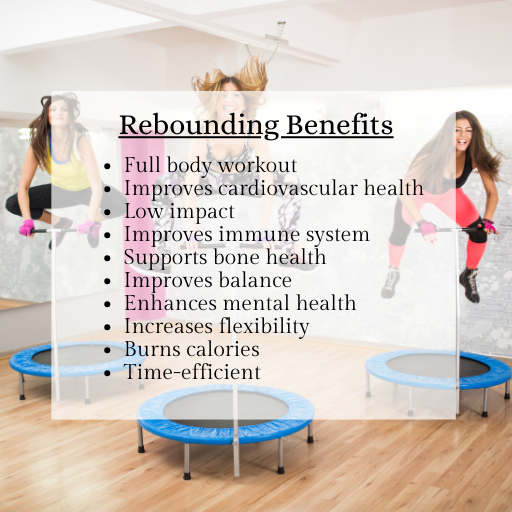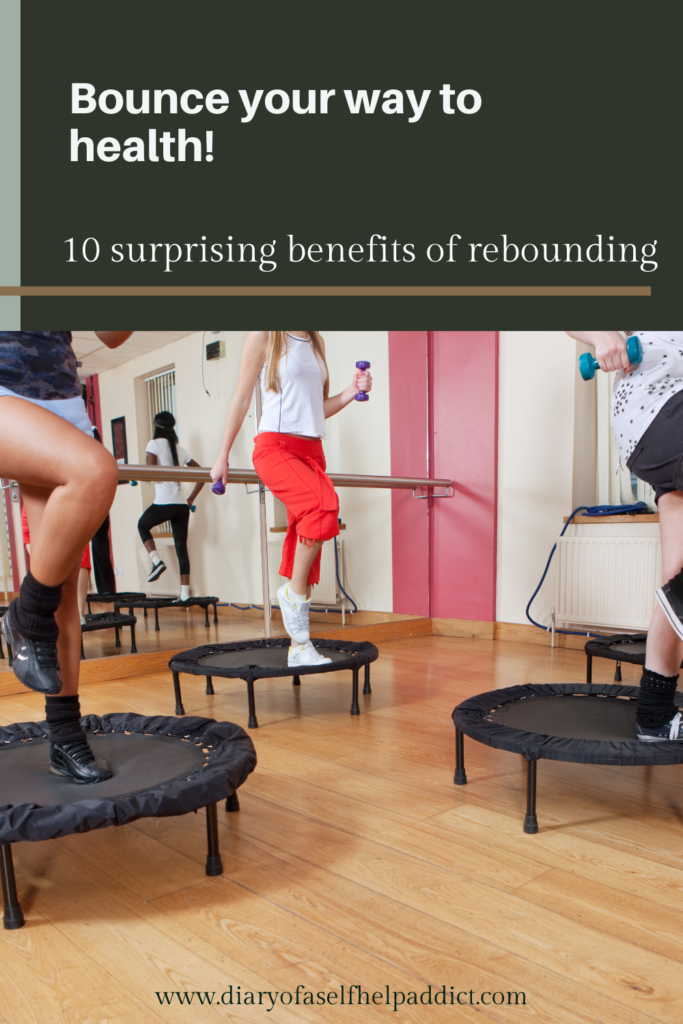
If you’ve ever found yourself stuck in a workout rut or searching for a fun way to stay active, consider a rebounder. That’s right—a mini-trampoline! Rebounding is one of the most exciting and effective ways to improve your health while having a blast. Whether you’re looking to boost your fitness, shed some pounds, or improve your overall well-being, rebounding has profound benefits that can help you meet your goals. Let’s jump into why rebounding should be your new favorite workout.
What is Rebounding?
Before we get into the benefits, let’s cover the basics. Rebounding involves jumping on a mini-trampoline, also known as a rebounder. This low-impact exercise involves small, controlled movements like bouncing, jumping, and even running in place on the rebounder. It’s a versatile workout that can be done at home, at the gym, or even outside if you want to enjoy some fresh air. Plus, it’s super fun—there is something about jumping that makes you feel like a kid again!
1. Rebounding is a Full-Body Workout
One of the most significant health benefits of rebounding is that it works your entire body. Every muscle is engaged from your legs to your core and arms as you bounce up and down. Even small movements on the rebounder can activate your stabilizing muscles, helping to build strength, balance, and coordination. If you’re looking for a workout that will tone, sculpt, and improve muscle definition, rebounding is the way to go.
Why this matters: Engaging multiple muscle groups simultaneously burns more calories and improves overall muscle tone. This makes rebounding an efficient and effective full-body workout.

2. Improves Cardiovascular Health
Rebounding is great for your heart! Bouncing on a mini-trampoline gets your heart rate up, which helps improve cardiovascular health. Regularly working out on a rebounder strengthens the heart and lungs, improves circulation, and may even lower your blood pressure over time.
In fact, NASA once conducted a study that showed rebounding to be more effective than running when it comes to improving cardiovascular fitness. This means you can get an intense cardio workout without the strain running puts on your joints!
Why this matters: A robust cardiovascular system means better endurance, more energy, and reduced heart disease and stroke risk.
3. Low-Impact on Joints
Unlike many other forms of exercise, like running or jumping on hard surfaces, rebounding is incredibly gentle on the joints. The mini-trampoline absorbs much of the impact, meaning your knees, hips, and ankles are protected as you jump. This makes rebounding an excellent option for people with joint pain, arthritis, or anyone looking for a workout that’s kind to the body while still being highly effective.
Why this matters: If you’ve been sidelined from high-impact exercises due to injury or joint pain, rebounding offers a safe and fun alternative to stay active without aggravating your joints.
4. Boosts Lymphatic Drainage, Detoxification, and Immune System
One of rebounding’s lesser-known yet powerful benefits is its ability to stimulate the lymphatic system, which is essential for detoxification and immune health. Unlike the circulatory system, the lymphatic system doesn’t have a pump to move fluid, so it relies on muscle movement to stay active. Rebounding’s up-and-down motion provides the perfect rhythmic movement needed to promote lymphatic drainage, helping your body flush out toxins, waste, and excess fluid.
This increased lymphatic activity is vital in supporting your immune system. By improving the circulation of lymph fluid, rebounding helps transport white blood cells more effectively, boosting your body’s ability to fight off infections and stay healthy.
Why this matters: A well-functioning lymphatic system is critical for detoxifying the body and strengthening the immune system. Regular rebounding helps keep lymph fluid moving, enhances your body’s natural defenses, contributes to overall well-being, and reduces bloating and fluid retention.
5. Supports Bone Health
Looking to build stronger bones? Rebounding is an excellent way to promote bone density. The gentle yet effective impact of bouncing helps stimulate the growth of bone tissue, which can improve bone strength over time. For those concerned about osteoporosis or age-related bone loss, rebounding offers a fun, low-risk way to support bone health.
Why this matters: Building strong bones helps prevent fractures, falls, and osteoporosis. The weight-bearing nature of rebounding strengthens your bones without the stress that running or other high-impact activities can cause.

6. Improves Balance and Coordination
Rebounding requires stability and control, which means that your body constantly works to maintain balance as you jump. Over time, this helps improve your coordination, balance, and spatial awareness. These are essential skills for everything from sports performance to preventing falls as we age.
Why this matters: Improved balance and coordination translate into better agility, posture, and stability in everyday life. Plus, it makes you more confident in your movements—whether dancing, playing sports, or walking on uneven terrain.
7. Enhances Mental Health
Physical activity and mental health go hand-in-hand, and rebounding is no exception. The combination of movement, rhythmic bouncing, and the sheer fun of jumping helps release endorphins—the body’s feel-good chemicals. Rebounding is an excellent way to reduce stress, fight off anxiety, and improve your mood. It’s like a mini happiness boost with every bounce!
In addition to reducing stress, rebounding can also improve your focus and concentration. Jumping requires mental engagement and coordination, which sharpens cognitive function and can even improve your memory.
Why this matters: Exercise is a natural way to combat feelings of anxiety, depression, and stress. Rebounding offers a fun, easy, and effective way to lift your spirits and clear your mind.
Check out this Beginner Rebounder Video on YouTube from Strong Tower Pilates Studio
8. Increases Flexibility
While rebounding may not seem like the most obvious flexibility booster, it actually helps improve range of motion over time. As you bounce, your muscles become more pliable, allowing for better flexibility. Rebounding can also help loosen tight muscles and joints, making it a great warm-up or cool-down exercise in any fitness routine.
Why this matters: Improved flexibility enhances mobility and can reduce the risk of injury. Plus, it makes everyday activities, like bending, reaching, and stretching, much more accessible.
9. Burns Calories and Supports Weight Loss
Let’s face it—losing weight can sometimes feel like a chore. But with rebounding, shedding those extra pounds becomes a fun and exciting challenge. Bouncing on a mini-trampoline burns a surprising number of calories! In just 20 minutes, you can torch anywhere from 150 to 300 calories, depending on the intensity of your workout. Moreover, rebounding is a whole-body workout; it helps increase your metabolic rate, allowing you to burn calories long after your session.
Why this matters: For those looking to lose weight, rebounding is a great way to burn calories, improve muscle tone, and enjoy the process—because when your workout is fun, you’re more likely to stick with it!

10. Convenient and Time-Efficient
One of the best parts about rebounding is its convenience. All you need is a mini-trampoline and a small space, and you’re good to go! Whether you’re bouncing in your living room, on your patio, or even in your office, rebounding fits easily into a busy lifestyle. A short 15-20-minute session can give you the same benefits as longer, more strenuous workouts, making it an ideal option for those with tight schedules.
Why this matters: You don’t need a gym membership, fancy equipment, or hours of free time to get fit with rebounding. It’s a simple, quick, and effective way to stay healthy, even on the busiest days. No excuses since you can rebound in the comfort of your home- which will keep you committed to your exercise routine.
How to Get Started with Rebounding
If you’re new to rebounding, it’s essential to start slow. Begin with short sessions of 5-10 minutes and gradually increase the time as you become more comfortable. Focus on small, controlled bounces at first, and as your balance and strength improve, you can add more dynamic movements like high knees, jumping jacks, or twists.
There are also plenty of online workouts and tutorials to guide you if you want a more structured routine. Wear comfortable clothing, keep some water nearby, and have fun! Depending on the recoil of your rebounder springs and mat, you may wear supportive sneakers to avoid straining your feet when you bounce. I prefer to work out barefoot on my rebounder.
Choosing the Right Rebounder: Features to Consider
When it comes to choosing a rebounder, there are several styles available, each offering different features and benefits. Some rebounders come with springs, while others use bungee cords, which can provide a quieter and softer bounce. Some models include a balance bar, which is a great option for beginners or those needing extra stability while jumping. If space is an issue, look for rebounders that fold in half for easy storage when not in use.
There’s no one-size-fits-all when it comes to rebounders, and prices vary based on the type of materials used and added features. Here’s a link to the rebounder I use and the one I bought for my parents back in 2020. It’s been a great option for us, but you can find a variety of rebounders online to suit different needs and budgets!
AS AN AMAZON ASSOCIATE, I EARN FROM QUALIFYING PURCHASES. READ MY DISCLOSER HERE. THANK YOU FOR SUPPORTING MY SMALL BUSINESS!
Final Thoughts: Rebounding is the Ultimate Fun and Effective Workout
Rebounding offers a wide range of health benefits beyond physical fitness. It’s a full-body workout that strengthens muscles, improves cardiovascular health, and supports detoxification while being gentle on the joints. Plus, it’s a fantastic way to boost your mental health, improve balance, and burn calories in a fun, stress-free way.
Whether you’re looking to add a new element to your workout routine or want a fun way to stay active, rebounding is a great option for people of all ages and fitness levels. So, what are you waiting for? Grab a rebounder and start jumping your way to better health today!
Let me know in the comments what your favorite type of workout is and if you’ve ever tried rebounding.
Pin it for later


[…] Related Read: 10 SURPRISING HEALTH BENEFITS OF REBOUNDING: THE ULTIMATE WORKOUT […]